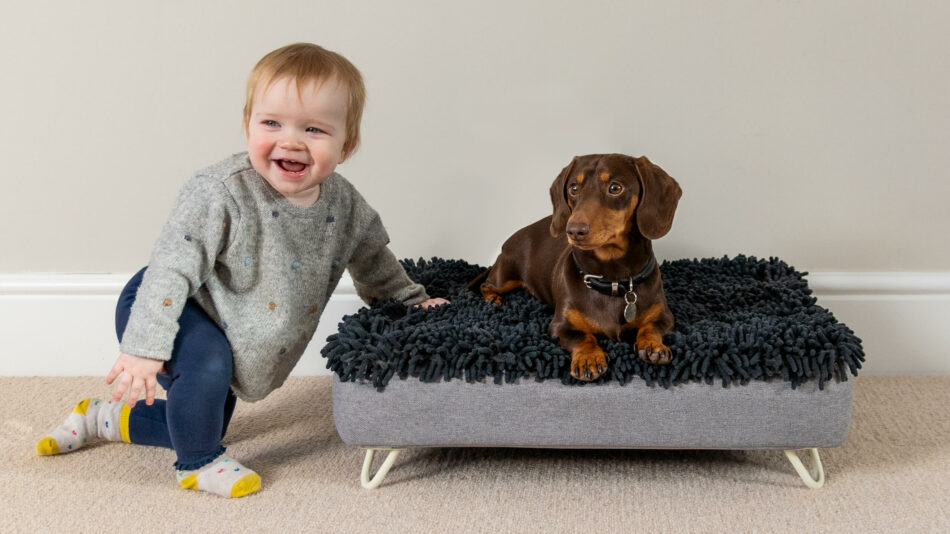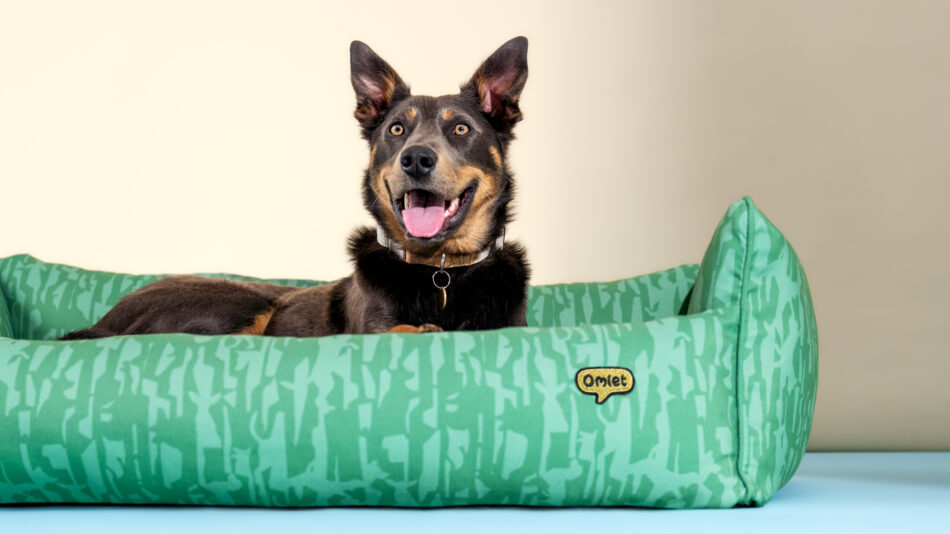Everything you need for a happy and healthy dog
Researching everything you need for a happy and healthy dog? You’re in good company. Dogs are the most popular pets all around the world, with an average of one-third of households globally containing at least one canine. There’s a reason why they’re called man’s best friend, but how can we be sure they’re getting everything they need from us? Here’s a guide to what dogs need to live long, happy lives, and how to spot a dog that isn’t thriving in their environment.
Every dog should have its day — everyday
Dogs are well known for radiating positivity and love. But to foster this eternal optimism, we have to ensure our dogs’ basic needs are met. While there are a multitude of ways to accomplish this, here are the basics of canine care:
- Safe, supportive, and sanitary living conditions with a comfortable dog bed or dog crate, a leash and collar or harness for walks, and items to clean up after them.
- Quality food and fresh water served in easy to clean dog bowls.
- Exercise and enrichment in the form of quality time spent with you, a variety of toys, and time spent training basic commands and tasks.
- Routine veterinary care and checkups to receive necessary vaccinations and maintain overall and long-term health.
When all of these needs are fulfilled, dogs are able to live long, happy lives — bringing us joy and companionship that is unique to the canine species. Here’s an in-depth look at how to practically provide your dog with their basic needs.
Conditions fit for a canine
Dogs deserve a supportive environment — in fact, it’s essential to their well-being. Most dogs thrive best inside with their owners, and should have their own designated spaces for eating and sleeping. Feed your dog in the same place each time they’re fed, and place their dog bed in a common area for them to catch a nap where the rest of your family relaxes. Orthopedic, comfy dog beds support growing puppies and aging dogs alike, giving them the deep, relaxing sleep they need for their overall health.
With some exceptions, many dogs find comfort in having a dog crate. Dogs are den animals by nature, and they like having a space that they can call their own. In addition to appealing to your dog’s nature, dog crates also provide a safe, practical space for dogs to stay in while their owners are away from home. And, since dogs don’t like to go to the bathroom where they sleep, crates can be a valuable potty training tool.
Other tips for making your home more dog-friendly include:
- Keeping noise levels down, as dogs have much keener hearing than we do.
- Laundering their dog bed cover routinely to keep it fresh.
- Make sure visitors know about your dog and can follow your guidelines for safe interaction.
Your dog’s diet
We may think that eating the same food every meal would be boring, but for your dog, this routine keeps their digestion and overall health in order. Dogs should be exclusively fed quality food formulated for their size and age range. Some dogs can be offered treats as a reward during training sessions, but treats should always be given sparingly to prevent your pup from becoming overweight or experiencing digestive upset.
Choose a dog food that doesn’t contain too many fillers like corn, and make sure it’s an appropriate formulation for your dog. Puppies need puppy food to receive adequate nutrition for their growth, while mature dogs need a different ratio of nutrients to support a healthy weight and joint health. Large breeds need additional nutrients that support their bones and joints that regular or small breed dog food may be lacking in.
Your veterinarian will be able to help you make the best dietary decisions based on your dog’s age, size, and overall health needs. And remember, if you’re switching up your dog’s food, do so slowly over the course of 2 weeks to avoid upsetting your pup’s stomach. Feed your dog according to their waistline — not the recommendations on the bag — and wash their bowls weekly to prevent bacteria from building up. Always have fresh water readily available, kept out of direct sunlight and in the same location for your dog to find easily.
Attention, training, and quality time
One of the best things about having a dog is that you have a companion that’s ready for adventure at a moment’s notice. Most dogs are thrilled at the prospect of a walk, playtime, or even just a quick pat on the head in passing. It’s part of what makes dogs such amazing pets.
But as much as we enjoy time with our dogs, most dogs crave time with us. It’s important to give ample attention to your dog, and provide them with plenty of outlets to expel their energy. Some dog breeds and individual dogs are more high strung than others, requiring a “job” or additional training to keep their active minds engaged.
Aim to spend a set amount of time each day with your dog. This could be in the form of a walk, a training session, or playtime. Time spent with your canine companion not only strengthens your bond, but also gives your dog a sense of purpose and belonging. Even just 15-30 minutes a day spent interacting with your dog will go a long way in keeping their minds sharp and energy expelled.
Veterinary care
Shots are no fun — but getting sick is a lot worse. It’s important that puppies complete all of the recommended rounds of vaccinations, usually 3-4 sets spaced out in 3-4 week intervals. Some of these vaccinations, like rabies vaccinations, are required by law, while others are to prevent canine-specific diseases. Don’t take your puppy to public places where dogs frequent, like the dog park or pet stores, until they are fully vaccinated.
Regular checkups are important throughout your dog’s life. These visits should occur at least once or twice a year depending on your dog’s age and overall health. Spaying or neutering your dog is recommended starting at 6 months of age, but large breed dogs may benefit from delaying this procedure by a few months to help their musculoskeletal development. Your veterinarian may recommend bloodwork to make sure your dog is aging gracefully, or a dental cleaning to keep their oral health on track.
Like human health, our dog’s health is a journey. Follow your veterinarian’s guidelines, and work to keep your dog at a healthy weight to prevent health conditions from developing. Plenty of exercise, a good diet, routine vet visits, and a loving home are a winning combination to a happy, healthy dog.
How can I tell if my dog is happy and healthy?
Subtly isn’t a trademark of the canine species. Dogs wear their positive emotions on their metaphorical sleeves, and a happy dog is a sight to behold. Here are the signs of a happy, healthy dog:
- Shiny coat, and bright, clear eyes
- Wagging tail, and alert expression when spoken to
- Their ribs can be felt with soft palpation, but not seen, and they have a defined waistline
- They move evenly and surely on all four legs
- Their water and food intake is consistent
- Regular potty breaks with formed stool that’s easy to pick up
- No noticeable breathing sounds (with the exception of brachycephalic breeds like Bulldogs, Pugs or Boston Terriers)
- They seem at ease in their surroundings, without displaying nervous behaviors like shaking, hiding, or tucking their tail
- No deviations in normal personality or behavior
Some dogs are naturally more reserved than others, and some pups may prefer a quiet movie night with you over a game of fetch. What’s important is consistency in your dog’s demeanor and appearance.
Here are some signs that your dog is not happy, or may be experiencing issues with their health:
- Dull or flaky hair coat
- Shaking their head repeatedly, especially with smelly or red ears
- Tucked tail, or hunched back
- Skittish behavior, or constantly hiding
- Decreased appetite
- Vomiting or loose stool
- Inappropriate or increased urination, especially with increased drinking
- Noticeable sounds when breathing
- Limping, difficulty standing, or trembling legs
- Obsessively licking paws or forelegs
- Increased vocalizations, particularly in response to sounds
- Nipping or other behavioral issues
If you notice any changes in your dog, or are concerned about their behavior, contact your veterinarian. Some changes may have a simple solution such as missing nutrients or minor environmental changes.
Omlet and your dog
Dogs share a remarkable bond with humans that spans centuries. That’s why we create remarkable dog beds, dog crates, and dog accessories that celebrate our unique relationship with these canine companions. Long live happy, healthy dogs.
This entry was posted in Dogs


